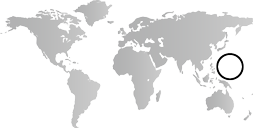The twentieth century represents a tumultuous period of cultural, political, and artistic upheaval for the peoples of Micronesia. In 1900, Germany controls the vast majority of the region, including the Marshall, Caroline, and Northern Mariana Islands as well as Belau and Nauru. Britain holds a protectorate over Kiribati, which later becomes a formal colony, while the United States has political authority over Guam. The presence of larger numbers of Westerners and the continuing activities of Christian missionaries have an increasingly profound impact on many Micronesian cultural and artistic traditions.
From 1908 through 1910, the Hamburg Südsee Expedition, traveling widely among Germany’s colonial possessions, documents the arts and cultures of Belau and the Caroline and Marshall Islands. The expedition also acquires vast collections of Micronesian art and material culture. Museums and universities in other parts of Germany also assemble substantial holdings of Micronesian objects. Following the German defeat in World War II, the League of Nations transfers authority over Germany’s Micronesian possessions to Japan.
The Japanese colonial period witnesses the further erosion of Micronesian art and culture. In one instance, however, a Japanese expatriate is responsible for the development of a new tradition within Micronesian wood carving. During the 1930s, folklorist Hijikata Hisakatsu (1900–1977) persuades Belauan artists to carve scenes depicting incidents from their traditional histories and legends, traditionally carved and painted on the rafters of ceremonial houses, on smaller portable boards for sale to outsiders. The creation of these “storyboards” develops into an important Belauan art form, which continues to the present. The late 1930s and early ’40s are also marked by the increasing construction of fortifications, airstrips, and other military installations throughout Japan’s Micronesian territories as the nation prepares for war.
Of all the cultural regions of the Pacific, Micronesia is the most severely impacted by World War II. Between 1941 and 1945, Allied and Japanese forces fight many of the major battles of the Pacific campaign on Micronesian islands. These include Tarawa in Kiribati, Chuuk (then known as Truk) in the Caroline Islands, Peleliu in Belau, and Saipan in the Mariana Islands. In 1945, the aircraft Enola Gay takes off from Tinian in the Marianas to drop the atomic bomb on Hiroshima. After the Allied victory, control of Japan’s Micronesian possessions is transferred to the United States, which administers them as a Trust Territory. In 1946, the U.S. begins the first in a series of nuclear weapons tests in the Marshall Islands when it detonates an atomic bomb on Bikini Atoll. The testing program ends in 1958.
In the 1960s, the islands and archipelagos of Micronesia gradually begin to achieve political independence. Nauru is first in 1968, followed by Kiribati in 1979, Belau in 1981, and the Federated States of Micronesia (encompassing all the Caroline Islands except Belau) and Republic of the Marshall Islands in 1986. At the end of the century, only Guam and the Commonwealth of the Northern Mariana Islands, the majority of whose inhabitants vote to remain part of the United States, are under the authority of a foreign nation.
For Micronesia’s artistic traditions, the first half of the twentieth century sees a dramatic decline in many art forms as the result of colonial and missionary influences. A number of Micronesian sculptural traditions, such as the creation of dilukái (female gable figures) in Belau, and masks in the Mortlock Islands (part of the Caroline Islands), cease to be practiced during this period. However, other art forms such as the carving of hos (weather charms) and seated figures in the Caroline Islands, the construction of the elaborately decorated ceremonial houses in Belau, as well as the majority of women’s arts, such as weaving and plaiting, continue. The second half of the century sees a growing renaissance of Micronesian cultural and artistic traditions. In 1955, what will later become the Belau National Museum is founded in the capitol of Koror. The gradual independence of Micronesian nations that begins in the 1960s is accompanied by renewed interest and respect for indigenous art and culture. The numerous art forms that survived the colonial period are rejuvenated and taught to new generations of artists while others are revived. In the final decades of the century, a significant contemporary art movement begins to develop among Micronesian artists.
In Europe and the United States, the latter half of the twentieth century witnesses a growing awareness of the spare and elegant aesthetic qualities of Micronesian art. Micronesian objects, formerly considered simply as sources of anthropological information, begin to be appreciated and displayed as works of art. Initially, Micronesian pieces are incorporated into general exhibitions of Oceanic art, such as Arts of the South Seas in 1946 or The Art of the Pacific Islands in 1979. In the 1980s, museums and art galleries begin to mount exhibitions devoted exclusively to Micronesian art. These include broad surveys such as The Art of Micronesia in 1986, and explorations of specific traditions like Palau (Belau) in 1992.


